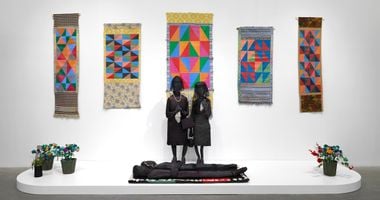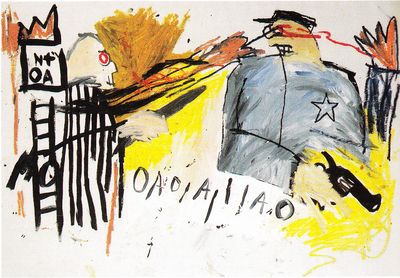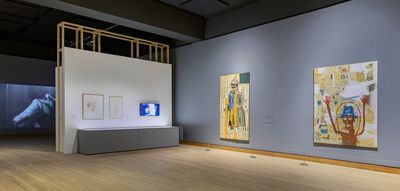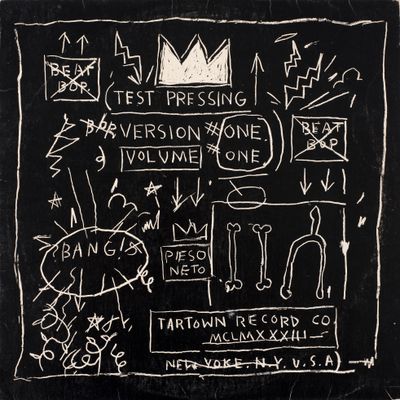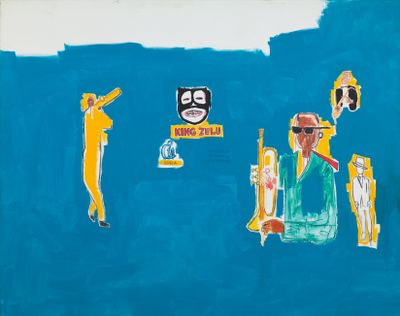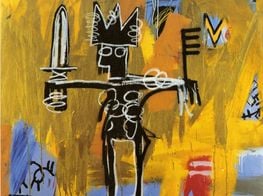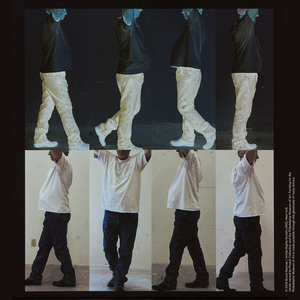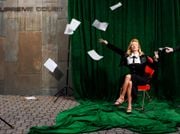Jean-Michel Basquiat: Beyond the Myth
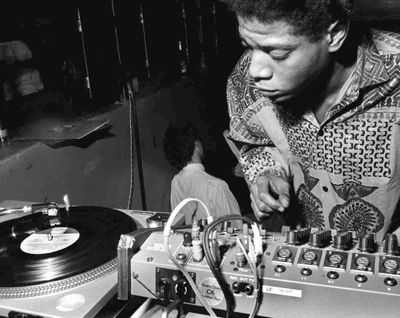
Basquiat DJing for Eric Goode's birthday party at Area (1984). © Ben Buchanan. Photo: Ben Buchanan.
Jean-Michel Basquiat's brief artistic life often gets bound up with Basquiat the myth. We know about his meteoric rise; his deserved or undeserved artworld stardom; his graffiti-inflected, Armani suit-wearing bad-boy image, and his tragic death by drug overdose at the age of 27.
But seldom do we get a nuanced exploration of Basquiat the thinker, or Basquiat the cultural alchemist. And certainly not Basquiat the musician, which makes Seeing Loud: Basquiat and Music at the Montreal Museum of Fine Arts (15 October 2022–19 February 2023), a refreshing dive into the sonic registers and traditions that inspired his art and worldview.
Curated by Mary-Dailey Desmarais, Dieter Buchhart, and Vincent Bessieres, the exhibition brings together over 100 paintings, audio clips, yet-to-be-seen videos, and notebooks. Seven sections take us through important stages in Basquiat's career, examining how music was both a unifying framework and impetus for his work.
The show opens with Basquiat's emergence as a key figure in New York City's downtown scene in the late 1970s, where he formed relationships with figures like hip-hop impresario Michael Holman, rapper Fab 5 Freddy, and graffiti artists such as Futura 2000. The artist moves through punk, hip-hop, and new and no wave subcultures that begin to mix and respond to each other.
After meeting Holman at the famed Canal Zone Party in 1979, Basquiat reveals his hitherto anonymous identity as the graffiti artist SAMO (same old), a moniker conceived with Al Diaz, after which he and Holman join friends to form the experimental band Gray.
In paintings and works on paper such as Untitled (Sheriff) (1981), Untitled (Lee Harvey) (1979–1980), and Old Cars (1981), Basquiat utilises collage and portraiture to represent people and sounds that influenced him at the time. Central themes emerge, including racism, police brutality, and relationships.
Another section adresses how Basquiat borrowed record and turntable techniques from hip-hop Djs—including sampling, scratching, duplicating, dubbing, and mixing—and brought them into the visual realm.
One exemplary work here is a portrait of graffiti artist and friend, Torrick Ablack. In Toxic (1984), the latter's figure is painted over a Xerox collage referencing jazz artists, African-American history, slavery, and minstrelsy, reflecting how Basquiat assembled and integrated cultural references into a contemporary tapestry grounded in sound.
Moving through a dimly lit section, we see audio clips and videos of early rap tracks—some including Basquiat, and one produced by the artist—that immerse viewers in a graffiti, breakdancing, b-boy posing milieu.
The show makes one thing very clear: Basquiat was a habitual straddler of cultures and worlds. He was very much of the scene, absorbing, filtering, and reflecting its acoustic surroundings, as flyers, promotional advertisements, and posters bearing his name demonstrate.
While hip-hop was an important muse, it was Basquiat's love for and understanding of jazz that propelled sonic integration within his canvases, and allowed the artist to synthesise numerous Black traditions.
The show makes one thing very clear: Basquiat was a habitual straddler of cultures and worlds.
From his early exposure to jazz in the familial home, to his later learning of its African origins from reading books like Robert Farris Thompson's Flash of the Spirit: African & Afro-American Philosophy (1983), Basquiat developed his art to push against attempts to discredit the contribution of Black arts to the American cultural fabric.
In the collage drawing Untitled (All Stars) (1983), Basquiat calls out racial discrimination experienced by Black artists. He cites Charlie Parker's legendary album, jazz drummer Max Roach, and Charles Correll and Freeman Gosden—two white actors who voiced Black characters in early 20th-century radio shows.
At the bottom right corner, Basquiat includes a sketch of slaveholding U.S. president Andrew Jackson's face, delivering a biting dialectical work that positions Black artistic output amid the continuum of racism.
Also on view are Basquiat's notebooks, which share the dark humour and distrustful wit of his paintings. In one, he mocks euphemistic language: 'THERE'S A SONG ON THE RADIO WHERE THEY SAY WAVY HAIR INSTEAD OF BLACK ... CONSIDERABLE CLOUDINESS ... IT WAS SUNG BY SOME WHITEGIRLS 20 YEARS LATER'. In another, he simply writes 'THE DOG DIED' at the top corner of a sheet of lined paper, leaving viewers to imagine the rest.
Further reflecting Basquiat's musicality and play with language are random lists, names, phone numbers, reading references, and most importantly, clusters of words that sometimes take the shape and form of poems.
But the curatorial peak is reached in a later section titled 'Basquiat and the Music of the Black Atlantic'. Presented in a large room with noticeably fewer works, the paintings are given room to breathe and speak.
Three works are outstanding. In the acrylic and oil painting Negro Period (1986), Basquiat sketches jazz artists Charlie Parker (whose music the painter adored) and Lester Young, while including African animals and other images alluding to science and technology. Made in the year Basquiat travelled to Africa, we see how he situates Black vernaculars within a trans-Atlantic, diasporic cosmology.
Basquiat developed his art to push against attempts to discredit the contribution of Black arts to the American cultural fabric.
In a stunning acrylic and oil pastel collage titled Slave Auction (1982), Basquiat connects the painful experiences of Black populations from the Middle Passage to the contemporary by depicting a seascape replete with slaves, ships, and slave catchers satirically outfitted in referee shirts.
King Zulu (1986) likewise shows a series of visual references that subtly mine the complex and important racial histories of blues and jazz. Here, all of Basquiat's aesthetic and thematic threads come together and bend back to their source.
It's nearly impossible to leave Seeing Loud: Basquiat and Music with the same over-sensationalised notion of the artist. Following this eclectic and immersive journey through Basquiat's love and respect for music, a more complex version of the artist, thankfully, emerges. —[O]




